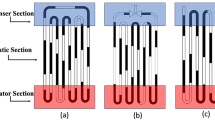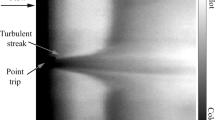Abstract
Using Taguchi's method, the best heat transfer locations for the heating and cooling systems are optimized. To investigate the flow field and heat transfer, the double multi-relaxation time lattice Boltzmann method is used. Sixteen different positions for heating and cooling systems are investigated, the full factorial method for the proposed model considers \({4}^{4}=256\) experiments, but using the Taguchi method can significantly reduce the number of experiments. In this study, with respect to the number of parameters and levels, the orthogonal array \({L}_{16}\) of Taguchi's method is proposed which reduces the number of experiments to 16. Various simulations are performed based on the design of the experiments, and the process output changes are measured by a factor called the signal-to-noise ratio. The optimal positions of the heating and cooling systems to maximize and minimize the Nusselt number are found. Also, using analysis of variance (ANOVA), the effective parameters and the percentage of participation of each of them on the Nusselt number are evaluated. In addition, the results show that the height position of the heating system has the greatest effect on the Nusselt number, while the longitudinal position of the cooling system has the least effect.













Similar content being viewed by others
Abbreviations
- \(E_{i}\) :
-
Distribution function for velocity field
- \(f_{i}\) :
-
Distribution function for temperature field
- β :
-
Thermal expansion coefficient
- \(\rho\) :
-
Density
- u :
-
Velocity in x direction
- v :
-
Velocity in y direction
- w :
-
Velocity in z direction
- \(\nu\) :
-
Kinematic viscosity
- g :
-
Gravity
- θ :
-
Temperature
- \(\Pr\) :
-
Prandtl number
- µ :
-
Dynamic viscosity
- k :
-
Thermal conductivity
References
Abbassi MA, Safaei MR, Djebali R, Guedri K, Zeghmati B, Alrashed AA (2018) LBM simulation of free convection in a nanofluid filled incinerator containing a hot block. Int J Mech Sci 144:172–185
Aghaie AZ, Rahimi AB, Akbarzadeh A (2015) A general optimized geometry of angled ribs for enhancing the thermo-hydraulic behavior of a solar air heater channel–a Taguchi approach. Renew Energy 83:47–54
Ahmad M, Shahzad A, Akram F, Qadri MNM (2022) Determination of efficient configurations of vertical axis wind turbine using design of experiments. Proc Inst Mech Eng Part A J Power Energy 236:09576509221095347
Akbarzadeh Tootoonchi A, Fallah M, Mahpeykar SN, Nabavi N (2012) Application of Taguchi optimization method in active vibration control of a smart beam. AMR-Adv Mater Res 488:1777–1782
Alinejad J, Esfahani JA (2017) Taguchi design of three dimensional simulations for optimization of turbulent mixed convection in a cavity. Meccanica 52(4):925–938
Allamraju KV (2018) Voltage optimization of piezoelectric circular transducer by Taguchi and ANOVA approches. Mater Today Proc 5(2):5322–5327
Benotsmane R, Dudás L, Kovács G (2020) Trial-and-error optimization method of pick and place task for RV-2AJ robot arm. In: Vehicle and automotive engineering. Springer, Berlin, pp 458–467
Chamkha AJ, Dogonchi A, Ganji D (2018) Magnetohydrodynamic nanofluid natural convection in a cavity under thermal radiation and shape factor of nanoparticles impacts: a numerical study using CVFEM. Appl Sci 8(12):2396
Clerc M (2010) Particle swarm optimization. Wiley, New York
Dorigo M, Birattari M, Stutzle T (2006) Ant colony optimization. IEEE Comput Intell Mag 1(4):28–39
Farkach Y, Derfoufi S, Ahachad M, Bahraoui F, Mahdaoui M (2022) Numerical investigation of natural convection in concentric cylinder partially heated based on MRT-lattice Boltzmann method. Int Commun Heat Mass Transf 132:105856
Ghasemi K, Siavashi M (2020) Three-dimensional analysis of magnetohydrodynamic transverse mixed convection of nanofluid inside a lid-driven enclosure using MRT-LBM. Int J Mech Sci 165:105199
He Y-L, Liu Q, Li Q, Tao W-Q (2019) Lattice Boltzmann methods for single-phase and solid-liquid phase-change heat transfer in porous media: A review. Int J Heat Mass Transf 129:160–197
Katata-Seru L, Lebepe TC, Aremu OS, Bahadur I (2017) Application of Taguchi method to optimize garlic essential oil nanoemulsions. J Mol Liq 244:279–284
Khanafer K, Vafai K, Lightstone M (2003) Buoyancy-driven heat transfer enhancement in a two-dimensional enclosure utilizing nanofluids. Int J Heat Mass Transf 46(19):3639–3653
Lohse D, Xia K-Q (2010) Small-scale properties of turbulent Rayleigh-Bénard convection. Annu Rev Fluid Mech 42:335–364
Luo L-S, Liao W, Chen X, Peng Y, Zhang W (2011) Numerics of the lattice Boltzmann method: effects of collision models on the lattice Boltzmann simulations. Phys Rev E 83(5):056710
Mahmoudi A (2020) Analysis of the convective heat transfer characteristics in a two-dimensional cavity subjected to an external magnetic field. Chin J Phys 68:618–632
Mamourian M, Shirvan KM, Ellahi R, Rahimi A (2016) Optimization of mixed convection heat transfer with entropy generation in a wavy surface square lid-driven cavity by means of Taguchi approach. Int J Heat Mass Transf 102:544–554
Mohammadi M, Nassab SG (2022) Combined influences of radiation and inclined magnetic field on natural convection in a cavity with complex geometry. Int Commun Heat Mass Transfer 134:106030
Nithyadevi N, Kandaswamy P, Sundari SM (2009) Magnetoconvection in a square cavity with partially active vertical walls: Time periodic boundary condition. Int J Heat Mass Transf 52(7–8):1945–1953
Rahman A, Redwan DA, Thohura S, Kamrujjaman M, Molla MM (2022) Natural convection and entropy generation of non-Newtonian nanofluids with different angles of external magnetic field using GPU accelerated MRT-LBM. Case Stud Therm Eng 30:101769
Roy RK (2010) A primer on the Taguchi method. Society of Manufacturing Engineers
Sajjadi H, Kefayati R (2015) Lattice Boltzmann simulation of turbulent natural convection in tall enclosures. Therm Sci 19(1):155–166
Sajjadi H, Kefayati GR (2016) MHD turbulent and laminar natural convection in a square cavity utilizing lattice Boltzmann method. Heat Transf Asian Res 45(8):795–814
Sajjadi H, Delouei AA, Atashafrooz M, Sheikholeslami M (2018) Double MRT Lattice Boltzmann simulation of 3-D MHD natural convection in a cubic cavity with sinusoidal temperature distribution utilizing nanofluid. Int J Heat Mass Transf 126:489–503
Sajjadi H, Delouei AA, Izadi M, Mohebbi R (2019) Investigation of MHD natural convection in a porous media by double MRT lattice Boltzmann method utilizing MWCNT–Fe3O4/water hybrid nanofluid. Int J Heat Mass Transf 132:1087–1104
Sajjadi H, Mohammadifar H, Amiri Delouei A (2020) Investigation of the effect of the internal heating system position on heat transfer rate utilizing Cu/water nanofluid. J Therm Anal Calorim 139(3):2035–2054
Sajjadi H, Ahmadi G, Amiri Delouei A (2021a) Effect of Inlet Air locations on particle concentration using large eddy simulation based on multi relaxation time lattice Boltzmann method. J Appl Comput Mech 7(4):1944–1955
Sajjadi H, Atashafrooz M, Delouei AA, Wang Y (2021b) The effect of indoor heating system location on particle deposition and convection heat transfer: DMRT-LBM. Comput Math Appl 86:90–105
Sajjadi H, Delouei AA, Mohebbi R, Izadi M, Succi S (2021c) Natural convection heat transfer in a porous cavity with sinusoidal temperature distribution using Cu/water nanofluid: Double MRT lattice Boltzmann method. Commun Comput Phys 29(1):292–318
Samanta R, Chattopadhyay H, Guha C (2022) A review on the application of lattice Boltzmann method for melting and solidification problems. Comput Mater Sci 206:111288
Seyyedi SM, Dogonchi A, Hashemi-Tilehnoee M, Asghar Z, Waqas M, Ganji D (2019) A computational framework for natural convective hydromagnetic flow via inclined cavity: an analysis subjected to entropy generation. J Mol Liq 287:110863
Sobhani M, Tighchi HA, Esfahani JA (2018) Taguchi optimization of combined radiation/natural convection of participating medium in a cavity with a horizontal fin using LBM. Physica A 509:1062–1079
Tahmooressi H, Kasaeian A, Tarokh A, Rezaei R, Hoorfar M (2020) Numerical simulation of aggregation effect on nanofluids thermal conductivity using the lattice Boltzmann method. Int Commun Heat Mass Transfer 110:104408
Varol Y, Öztop HF, Özgen F, Koca A (2012) Experimental and numerical study on laminar natural convection in a cavity heated from bottom due to an inclined fin. Heat Mass Transf 48(1):61–70
Wahid Z, Nadir N (2013) Improvement of one factor at a time through design of experiments. World Appl Sci J 21(1):56–61
Wang C-H, Liu Z-Y, Jiang Z-Y, Zhang X-X (2022) Numerical investigations of convection heat transfer in a thermal source-embedded porous medium via a lattice Boltzmann method. Case Stud Therm Eng 30:101758
Wen X, Wang L-P, Guo Z, Zhakebayev DB (2021) Laminar to turbulent flow transition inside the boundary layer adjacent to isothermal wall of natural convection flow in a cubical cavity. Int J Heat Mass Transf 167:120822
Zitzler E, Thiele L (1999) Multiobjective evolutionary algorithms: a comparative case study and the strength Pareto approach. IEEE Trans Evol Comput 3(4):257–271
Author information
Authors and Affiliations
Corresponding author
Appendix
Appendix
One of the advantages of evaluating the SN ratio in Taguchi's method is the possibility of determining the optimal levels and the effectiveness of each parameter. In SN ratio analysis, the level with the highest signal-to-noise average is equivalent to the best level for each parameter. This section attempts to express the SN ratio calculations as well as the ANOVA for maximizing the Nusselt number with Ra = 104. Table
9 shows the Taguchi L16 orthogonal array with the Nusselt number and the SN ratio values for each experiments. The value of the SN ratio for each experiments with respect to maximize the Nusselt number is as follows,
in which the values of the Nusselt number will substitute with parameter \({y}_{i}\).
Table
10 shows the SN ratio average for each factor at each level. In the last row of Table 10, the maximum variation of the SN ratio values, Δ, is given for each parameter. Higher values of Δ indicate that the parameter has a greater effect on the output of the problem.
For example, to calculate the value of the SN ratio average for parameter per level 1, the bolded data of Table 9 are used and are equal to,
The results of the analysis of variance (ANOVA) shown in Table
11 examine the effect of each parameter on the output.
For each of the input parameters in this table, the degree of freedom is defined separately, which equals the number of levels of that parameter minus one. Since four levels are considered for each parameter, the degree of freedom of each parameter is equal to three. Taking the number of experiments and subtracting one, we get the total degree of freedom. Therefore, the value of 15 is considered as the total degree of freedom. The degree of freedom of error is equal to the difference between the degree of total freedom from the sum of the degrees of freedom of the parameters. Therefore, in this study, the degree of freedom of error is equal to three.
Table 11 also shows the sequential sums of squares (Seq SS), adjusted mean squares (Adj MS), F-value test, and also percent contribution of each parameter on the output which is calculated as follows,
in which \(N\) is the number of SN ratio, \({A}_{i}\) is the sum of SN ratio values for parameter \(A\) at level \(i\), and parameter \({N}_{{A}_{i}}\) is the number of SN ratio of parameter \(A\) at level \(i\). For example, according to the results shown in Table 11, the values of the ANOVA table for the \({H}_{H}\) parameter are calculated as follows,
Rights and permissions
Springer Nature or its licensor (e.g. a society or other partner) holds exclusive rights to this article under a publishing agreement with the author(s) or other rightsholder(s); author self-archiving of the accepted manuscript version of this article is solely governed by the terms of such publishing agreement and applicable law.
About this article
Cite this article
Sajjadi, H., Nabavi, S.N., Atashafrooz, M. et al. Optimization of Heating and Cooling System Locations by Taguchi’s Method to Maximize or Minimize the Natural Convection Heat Transfer Rate in a Room. Iran J Sci Technol Trans Mech Eng 47, 1599–1614 (2023). https://doi.org/10.1007/s40997-023-00624-2
Received:
Accepted:
Published:
Issue Date:
DOI: https://doi.org/10.1007/s40997-023-00624-2




